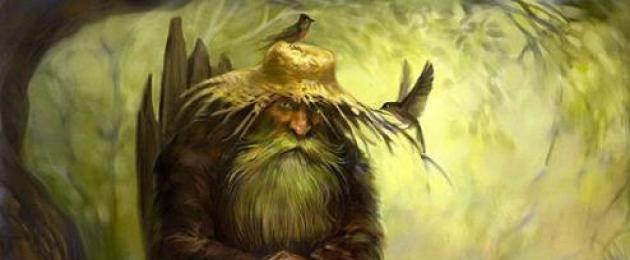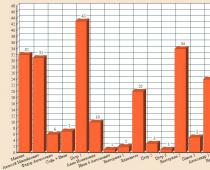Nations about the world, expressed in religious beliefs, rituals and cults. It is closely related to paganism and cannot be considered separately from it.
Slavic myths (summary and main characters) are the focus of this article. Consider the time of their origin, the similarity with ancient legends and tales of other peoples, the sources of study and the pantheon of deities.
Formation of Slavic mythology and its connection with the religious beliefs of other peoples
The myths of the peoples of the world (Slavic myths, ancient Greek and ancient Indian) have a lot in common. This suggests that they have a single beginning. Connects their common origin from the Proto-Indo-European religion.
Slavic mythology was formed as a separate layer of Indo-European religion over a long period - from the II millennium BC. e.
The main features of Slavic paganism, reflected in mythology, are the cult of ancestors, belief in supernatural forces and lower spirits, and the spiritualization of nature.
Ancient Slavic myths are strikingly similar to the legends of the Baltic peoples, Indian, Greek and Scandinavian mythology. In all the myths of these ancient tribes, there was a god of thunder: the Slavic Perun, the Hittite Perva and the Baltic Perkunas.
All of these peoples have a basic myth - this is the confrontation of the supreme deity with his main enemy, the Serpent. The similarity can be traced in the belief in the afterlife, which is separated from the world of the living by some kind of obstacle: an abyss or a river.
Slavic myths and legends, like the legends of other Indo-European peoples, also tell about heroes fighting with a snake.
Sources of information on the legends and myths of the Slavic peoples
Unlike Greek or Scandinavian mythology, the Slavs did not have their own Homer, who would be engaged in the literary processing of ancient legends about the gods. Therefore, now we know very little about the process of the formation of the mythology of the Slavic tribes.
The sources of written knowledge are the texts of Byzantine, Arab and Western European authors of the 6th - 13th centuries, Scandinavian sagas, Old Russian chronicles, apocrypha, teachings. In a special place is the "Lay of Igor's Campaign", which contains a lot of information about Slavic mythology. Unfortunately, all these sources are only a retelling of the authors, and they do not mention the legends in full.

Slavic myths and legends were also preserved in folklore sources: epics, fairy tales, legends, conspiracies, proverbs.
The most reliable sources for the mythology of the ancient Slavs are archaeological finds. These include idols of the gods, places of worship and ceremonies, inscriptions, signs and decorations.
Classification of Slavic mythology
A distinction should be made between the gods:
1) Eastern Slavs.
2) Western Slavic tribes.
There are also common Slavic gods.
The concept of the world and the universe of the ancient Slavs
Due to the lack of written sources, practically nothing is known about the beliefs and ideas about the world of the Slavic tribes. Fragmentary information can be gleaned from archaeological sources. The most illustrative of them is the Zbruch idol, found in the Ternopil region of Ukraine in the middle of the 19th century. It is a four-sided limestone pillar divided into three tiers. The lower one contains images of the underworld and the deities inhabiting it. The middle one is dedicated to the human world, and the upper tier depicts the supreme gods.
Information about how the ancient Slavic tribes represented the world around them can be found in ancient Russian literature, in particular, in the "Lay of Igor's Host." Here, in some passages, a connection with the World Tree is clearly traced, myths about which exist among many Indo-European peoples.
Based on the listed sources, the following picture is obtained: the ancient Slavs believed that an island (possibly Buyan) was located in the center of the World Ocean. Here, in the very center of the world, either the sacred stone Alatyr lies, which has healing properties, or the World Tree grows (almost always in myths and legends it is an oak tree). On its branches sits the bird of Gagan, and under it is the snake of Garafen.
Myths of the peoples of the world: Slavic myths (creation of the Earth, the appearance of man)
The creation of the world among the ancient Slavs was associated with such a god as Rod. He is the creator of everything in the world. He separated the obvious world in which people live (Reality) from the invisible world (Nav). The clan is considered the supreme deity of the Slavs, the patron saint of fertility, the creator of life.
Slavic myths (the creation of the Earth and the appearance of man) tell about the creation of all that exists: the creator god Rod, together with the sons Belbog and Chernobog, conceived to create this world. First, Rod from the ocean of chaos created three hypostases of the world: Reality, Nav and Rule. Then the Sun appeared from the face of the supreme deity, a month appeared from the chest, and the eyes became stars. After the creation of the world, the Rod remained in Prav, the dwelling place of the gods, where he guides his children and distributes responsibilities between them.
Pantheon of deities
Slavic gods (myths and legends about which have survived in very small numbers) is quite extensive. Unfortunately, due to the extremely scarce information, it is difficult to restore the functions of many Slavic deities. The mythology of the ancient Slavs was not known until the moment they reached the borders of the Byzantine Empire. Thanks to the records of the historian Procopius of Caesarea, it was possible to find out some details of the religious beliefs of the Slavic peoples. The Laurentian Chronicle mentions gods from the Vladimir pantheon. Having ascended the throne, Prince Vladimir ordered to place the idols of six important gods near his residence.

Perun
The Thunderer God is considered one of the main deities of the Slavic tribes. He was the patron saint of the prince and his squad. Among other peoples it is known as Zeus, Thor, Perkunas. First mentioned in the "Tale of Bygone Years". Even then, Perun led the pantheon of Slavic gods. Sacrifices were made to him by stabbing a bull, and oaths and agreements were fixed in the name of God.

The Thunderer God was associated with the hills, so his idols were installed on the hills. The holy tree of Perun was an oak.
After the adoption of Christianity in Russia, some of Perun's functions were transferred to Gregory the Victorious and Elijah the Prophet.
Solar deities
The sun god in Slavic myths was in second place in importance after Perun. Horse - that is what they called him. The etymology of the name is still unclear. According to the most common theory, it comes from the Iranian languages. But this version is very vulnerable, since it is difficult to explain how this word became the name of one of the main Slavic deities. The Tale of Bygone Years mentions Khors as one of the gods of the Vladimir pantheon. There is information about him in other ancient Russian texts.

Khors, the sun god in Slavic myths, is often mentioned along with other deities related to the heavenly body. This is Dazhbog - one of the main Slavic gods, the personification of sunlight, and Yarilo.
Dazhbog was also a deity of fertility. The etymology of the name does not cause difficulty - “the god giving prosperity”, such is his approximate translation. He played a double function in the mythology of the ancient Slavs. As the personification of sunlight and warmth, he gave fertility to the soil and at the same time was the source of royal power. Dazhbog is considered the son of Svarog, the god-blacksmith.
Yarilo - there are many ambiguities associated with this character of Slavic mythology. It has not yet been established exactly whether he should be considered a deity, or whether it is a personification of one of the holidays of the ancient Slavs. Some researchers consider Yarilo a deity of spring light, warmth and fertility, others - a ritual character. He was represented as a young man on a white horse and in a snow-white robe. On her hair there is a wreath of spring flowers. The deity of spring light holds ears of cereals in his hands. Where it appears, there will definitely be a good harvest. Yarilo also engendered love in the heart of the one he looked at.
The researchers agree on one point - this character of Slavic mythology cannot be called the god of the sun. Ostrovsky's play The Snow Maiden fundamentally misinterprets the image of Yarilo as a solar deity. In this case, Russian classical literature plays the role of harmful propaganda.
Mokosh (Makosh)
There are very few female deities in Slavic mythology. Of the main ones, you can only name such as Mother - Cheese Earth and Mokosh. The latter is mentioned among other idols installed by order of Prince Vladimir in Kiev, which speaks of the importance of this female deity.
Mokosh was the goddess of weaving and spinning. She was also revered as the patroness of crafts. Her name is associated with two words "wet" and "spinning". Mokoshi's day of the week was Friday. On this day, it was strictly forbidden to engage in weaving and spinning. As a sacrifice, Mokoshi was presented with yarn, thrown into a well. The goddess was represented in the form of a long-armed woman spinning at night in houses.

Some researchers suggest that Mokosh was the wife of Perun, so she was given an honorable place among the main Slavic gods. The name of this female deity is mentioned in many ancient texts.
After the adoption of Christianity in Russia, part of the features and functions of Mokosha passed to Saint Paraskeva-Friday.
Stribog
It is mentioned in the Vladimir pantheon as one of the main gods, but its function is not entirely clear. Perhaps he was the god of the winds. In ancient texts, his name is often mentioned along with Dazhbog. It is not known whether there were holidays dedicated to Stribog, since there is very little information about this deity.
Volos (Veles)
Researchers tend to believe that these are still two different characters in myths. Volos is the patron saint of pets and the god of wealth. In addition, he is the god of wisdom, the patron saint of poets and storytellers. No wonder Boyan from "The Lay of Igor's Campaign" is called Veles's grandson in the poem. As a gift, he was left on the field with several uncompressed stalks of cereals. After the adoption of Christianity by the Slavic peoples, the functions of Volos were taken over by two saints: Nicholas the Wonderworker and Vlasiy.

As for Veles, this is one of the demons, an evil spirit that Perun fought with.
Slavic mythical creatures - forest dwellers
The ancient Slavs had several characters associated with the forest. The main ones were the water and the goblin. With the advent of Christianity in Russia, they began to attribute exclusively negative traits, making them demonic creatures.
Goblin is the owner of the forest. They also called him a forest man and a forest spirit. He carefully guards the forest and its inhabitants. Relations with a good person are neutral - the goblin does not touch him, and he can even come to the rescue - take him out of the forest if he gets lost. The attitude towards bad people is negative. Their forest owner punishes: makes them wander and can tickle to death.

Before people, the goblin appears in different guises: human, plant, animal. The ancient Slavs had an ambivalent attitude towards him - the devil was revered and at the same time feared. It was believed that shepherds and hunters needed to make a deal with him, otherwise the goblin could steal cattle or even a person.
Water - a spirit that lives in water bodies. He was represented as an old man with a fish tail, beard and mustache. It can take the form of a fish, a bird, pretend to be a log or a drowned man. Especially dangerous during big holidays. The merman loves to settle in pools, under mills and sluices, in polynyas. He has herds of fish. He is hostile to a person, always trying to drag under the water the one who came to swim at an inopportune time (noon, midnight and after sunset). The favorite fish of the aquatic is the catfish, on which he rides like a horse.

There were other, lower beings, for example, the forest spirit. In Slavic myths, he was called Auka. He never sleeps. Lives in a hut in the very thicket of the forest, where there is always a supply of melt water. A special expanse for Auka comes in winter, when the gobies fall asleep. The forest spirit is hostile towards a person - it will try to get a random traveler in a windbreak or make him circle until he gets tired.
Bereginya - this mythical female character has an unclear function. According to the most common version, this is a forest deity that protects trees and plants. But also the ancient Slavs considered the Bereginas to be mermaids. Their sacred tree is birch, which was highly revered among the people.
Borovik is another forest spirit in Slavic mythology. Outwardly it looks like a huge bear. You can distinguish it from a real beast by the absence of a tail. Subordinate to him are boletus - the owners of mushrooms, similar to little old men.
Kikimora swamp is another colorful character in Slavic mythology. He does not like people, but he will not touch as long as the travelers are quiet in the forest. If they make noise and harm plants or animals, the kikimora can make them wander through the swamp. Very secretive, very rarely seen.
Swamp - a mistake will be to confuse him with a water one. The swamp among the ancient Slavs has always been considered a place where evil spirits dwell. The bog was presented as a terrible creature. This is either a motionless, eyeless fat man, covered with a layer of algae, silt, snails, or a tall man with long arms, overgrown with dirty gray wool. He does not know how to change his appearance. It poses a great danger to a person or an animal caught in a swamp. He grabs the victim, stuck in the bog, by the legs and drags him to the bottom. There is only one way to destroy the swamp - by draining its swamp.

Slavic myths for children - briefly about the most interesting
Acquaintance with samples of Old Russian literature, oral legends and myths is of great importance for the all-round development of children. Both adults and the smallest need to know about their past. Slavic myths (grade 5) will acquaint schoolchildren with the pantheon of the main gods and the most famous legends. The anthology on literature includes an interesting retelling of AN Tolstoy about Kikimor, there is information about the main characters in the mythology of the ancient Slavs, an idea of such a concept as "temple" is given.
If desired, parents can at an earlier age introduce the child to the pantheon of Slavic gods and other mythological creatures. It is advisable to choose positive characters, and not tell young children about such frightening creatures as navi, sinister, wolves.
For acquaintance with the characters of Slavic mythology, you can recommend the book by Alexander Asov "Myths of the Slavs for Children and Their Parents." It will be of interest to both the younger generation and the older. Svetlana Lavrova is another good author who wrote the book "Slavic Tales".
- In contact with 0
- Google+ 0
- OK 0
- Facebook 0








